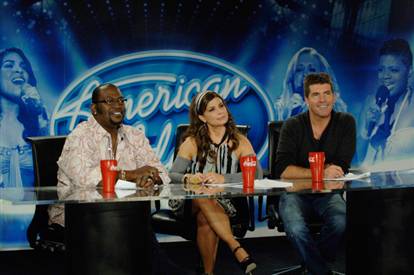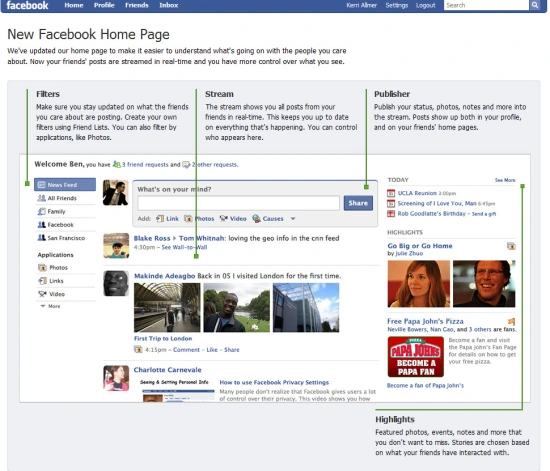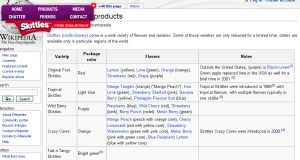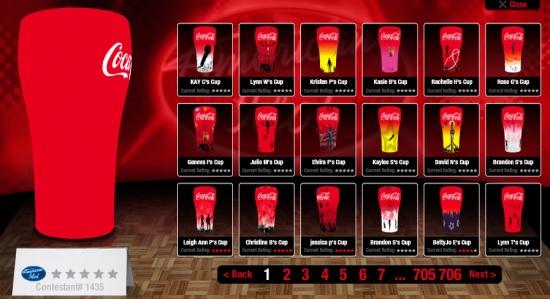New Domain Names Could Hurt Marketing Efforts
March 16, 2009 at 12:10 pm | Posted in Uncategorized | 1 CommentTags: domain names, ICANN, top-level domains
ICANN (Internet Corporation for Assigned Names and Numbers) recently announced they wish to expand the list of top-level domains available for companies to choose from. In other words, the end of a web address could be .candy, .plants, or .clothing instead of .com, .net or .org.
Tidbit of knowledge: there are currently 21 generic top-level domains

Sorry Mike & Ikes, Laffy Taffy's Shaking Its Stuff At .candy
Companies would be able to choose their new domain as it relates to their company or product. Laffy Taffy could choose to purchase the .candy domain, making their website http://www.laffytaffy.candy instead of http://www.laffytaffy.com. Here’s the catch- only one company can use each new domain. This means that if Laffy Taffy gets .candy, Mike & Ikes are outta luck. We could potentially see multi-million dollar bidding wars for a most-wanted domain, and there is no guarantee it would even be profitable.
See, here’s the problem. They tried this in 2005 when they introduced the .travel domain. Ever heard of it? Nope, didn’t think so. That’s because we are preconditioned to type .com at the end of a web address. Even if we know that the address should end with .net, we can’t help but think “if I type .com it will redirect me.” And that’s the problem that would occur if ICANN announces fair game on new domains. Big companies would feel obligated to purchase the domain names that relate to their company, for fear of cybersquatting. Once those domains were purchased, 1 of 2 things would happen: 1) those companies would have to shell out extra money to market those domain names; or 2) they would redirect their new domains to their main .com address. Either way, a lot of money is being spent on a completely unnecessary move.

Spend millions on a new domain name, or save someone's job? Seems like an obvious choice to me.
How much money? It would cost a company $185,000 just to register the domain, and then their annual fees could be between $25,000 and$75,000. Not much of a bargain. Plus, factor in the bidding wars between competing brands and you’ve got millions upon millions of dollars essentially being wasted.
With today’s economy, don’t you think we should be spending our money on more useful things? Like, oh I don’t know, avoiding layoffs? Just a thought.
Lose 15 lbs., Grow 4 Inches, and Learn Mandarin…Overnight!*
March 13, 2009 at 12:02 pm | Posted in Uncategorized | Leave a commentTags: diet pills, ftc, results not typical
*Results Not Typical
We’ve all seen them: commercials that “guarantee you’ll lose 15 lbs. in 2 weeks,” yet the fine print on the bottom of the screen says “results not typical.”
With all of the deception, how can consumers decide which products actually work? I think it’s about time that someone step in and set some rules about all of this false advertising.
Yesterday, the FTC announced they want to toughen the rules on testimonials so what is presented in the commercial actually represents typical results. These changes would mean a dramatic overhaul of the diet pill commercials which show 15 lb. weight loss in a week’s time; now the commercials would have to show the success consumers are likely to have.
The proposed changes have gotten some negative attention from marketers, including the Direct Marketing Association who claims these changes would place a “substantial burden on advertisers.” Some claim that guaranteeing results for certain products would be near impossible, and with these new rules in place, marketing for these products would also be near impossible.
To be honest, I think these companies have been getting away with unethical practices for too long. Advertising results that are not even close to the results an average consumer can expect to achieve is outrageous. Granted, most people realize that these products will never give them those results, but I think it’s pathetic that it’s gotten to that point. These companies shouldn’t have been able to advertise this way for so long.
What I don’t understand is if everyone knows that the results are bogus, why did these companies continue to advertise like this? Were they hoping to find an unsuspecting person who was dazzled by the hopes of dropping the equivalent of a toddler in 2 weeks time? Whatever the reason, I think these companies have been acting in an unethical manner for way too long and it’s about time someone stepped in.
You go, FTC!
Dance for me Dufon!
March 12, 2009 at 12:17 pm | Posted in Campaigns, Mobile Marketing | Leave a commentTags: dockers, dufon smith, iphone, iphone app, Mobile Marketing
Everyone knows that the iPhone has opened doors for new and innovative marketing efforts. With the advent of the App Store, companies have been able to create cool new ways to interact with their customers. One of the newest things to hit the iPhone is an ad that uses the phone’s motion-detecting feature. It’s the newest form of mobile marketing out there, and it’s pretty cool.
So what trendy company is introducing this new type of advertising? Oh, it’s Dockers. Not exactly the company I would expect to release a tech-savvy ad, as I equate with 45+ year old men. But according to the director of brand marketing, Dockers is trying to align themselves with a younger, edgier crowd. Their new iPhone ad is targeted towards 30-39 year old tech-savvy men, which falls within their new target market.
Dockers decided to use the iPhone as their medium so they could target their audience “when and where he’s open to our message.” According to AdAge,
The placement of the interactive ad in gaming applications makes a strong case for the target consumer to engage with the brand. “He’s in a gaming mode and in the mood to be entertained,” [Dockers director of brand management] said.
The ad features Dufon Smith, a self-proclaimed “freestyle expressionist of dance,” wearing a pair of Dockers khakis. Each time the user shakes the phone, Dufon performs some of his dance moves. Pretty cool if you ask me.
I’ll leave you with a video of Dufon doing his thing. Amazing.
Wait, There’s No More Checkout at the Grocery Store?
March 8, 2009 at 2:55 pm | Posted in New Technology | 2 CommentsTags: coupons, grocery store, marketing, scan it, stop and shop, technology
A few weeks ago, we had a discussion in my Emerging Media class about new media pushing old media out of the mix. Would the Kindle replace books? Would online news kill real newspapers? Would email mean the extinction of the USPS?
We all decided it would be a very long time before new media completely took over the world, if it ever did, just like the advent of television did not mean the death of radio. Although, there have been instances when a new technology changed how we lived. Remember VHS? What about days before DVR? Alright, are you still listening to cassette tapes? Chances are these products’ successors have a permanent place in your life…until a new product replaces them.
Whenever I see a new product hit the market, I wonder if it will be the product that ultimately changes our lives. I don’t think that people really thought the iPod would revolutionize the way we listen to music when it first hit the market, but now cars are being designed with the iPod in mind and CDs are considered to be from the stone age.

Stop and Shop Goes Hi-Tech with Scan It!
This thought ran through my head when I was at the grocery store last night. Stop and Shop just released “Scan It” which allows you to scan and bag your purchases as you shop, eliminating the need to “check out.” At the end of your visit, you scan your scanner at the register and your total pops up on the screen. Simply pay and you’re on your way!
Now, let me explain one sappy story behind this. There is a lovely little woman named Virginia who has been my Stop and Shop cashier for over a year now. She takes longer than most cashiers, but she is one of the nicest women I have ever met in my life. I don’t mind waiting on line to have good ‘ole Virge as my cashier. Last week, Virginia came in with a cast on her arm. The next week, the Scan It service was available. You want to know what ran through my head? “What if the scanners take over and cashiers aren’t needed? How will Virginia pay her medical bills?”
I know. That’s extreme. But you have to admit that it makes you think. 50 years down the road- will we need cashiers? Or will they just be a part of our distant memory?
Scan It’s Marketing Efforts
Besides being a way to avoid the checkout lines, the Scan It system allows companies to display coupons during the

Scan It- The newest medium for marketers?
visit. Periodically, my Scanner let out this extremely loud chime and a coupon for something would pop up on the screen. I always looked. Every. Single. Time. My boyfriend actually got annoyed, telling me “it’s another ad! You don’t need to keep looking at it!”
If I was looking at it every time it chimed, perhaps everyone else was as well. In that case, there is much opportunity available in this technology for marketers. Since shoppers use their Stop and Shop card to “rent” the scanner, there is the potential to gather data on each customer to display the most relevant coupons for them. The vegetarian shopper with a toddler at home may receive coupon ads for Morningstar Farms and Huggies, while the chicken eater with a little pup at home may receive coupons for Purdue and Milk Bones. How’s that for target marketing?
But before we get all excited about Scan It, let’s take a minute to think about Virginia and her livelihood. (By the way, you have no idea how much I wish I had a picture of Virginia to post. It would totally help my argument.)
If SpongeBob Told You to Jump Off a Bridge…
March 6, 2009 at 4:56 pm | Posted in Uncategorized | 1 CommentTags: childhood obesity, ethics, junk food marketing, marketing to children, marketing to kids
Chances are today’s youth would do it. And their parents would sue SpongeBob.
There are some staggering facts and figures floating around about the ethics of marketing to children. An article by Miriam Zoll tells us that “recent studies have shown that by the time they are 36 months old, American children recognize an average of 100 brand logos.” Another study published in 1991 found that “by age six, Old Joe (who was the face of Camel Cigarettes) is as well recognized as Mickey Mouse.” A study released in 2005 by the Institute of Medicine states that “advertising influences what children under 12 eat” and that spokes-characters are “being used to manipulate vulnerable children to make unhealthy choices.”

I mean, seriously. Way to go Old Joe. This is obviously your fault.
Companies have advertised to children for decades. In the 1990’s kids knew who Old Joe the Camel was, they knew what he was selling, but we didn’t have an onslaught of seven-year-old smokers. Why? Because our parents taught us that smoking was a bad decision, and it was a bad decision we weren’t allowed to make until we were grown-ups.
To be honest, I don’t know that many people my age who are smokers. We were exposed to cigarette ads, we watched people smoke in restaurants and bars, we knew who Old Joe was by the time we hit kindergarten… but for the most part, we turned out ok.
Now, here’s where it gets interesting. Parents of young children have formed coalitions against marketing junk food to children because it’s directly causing the children to become obese. The scary part is that there actually is an epidemic of childhood obesity in this country. Is it because food companies came up with a few jingles and hired a guy in a furry costume to dance around during their commercials?
No way.
It’s the parents’ fault their kids are obese. Even if kids are exposed to messages from junk food companies on a daily basis- they should be exposed to messages from their parents on daily basis about healthy eating, getting some exercise, not doing drugs, not drinking….you know, the things we all heard from our parents when we were growing up.
I think it’s about time that parents take a more proactive approach when raising their children, and stop blaming

But Daddy, I want it now!
every problem they encounter on advertising and big corporations. Parents need to realize that they can actually say no to their children (but seriously, tell your 8-year-old he’s NOT getting the $200 iPhone). Parents today seem to be under pressure to constantly please their children, but that’s not their role. Their role is to raise responsible, well-balanced people. Doing so takes discipline and perseverance, and telling your child “no” when need be.
Here’s one other staggering fact about today’s children, as reported by the Kaiser family Foundation: the majority of young people say their parents don’t impose any rules on them regarding their use of TV, video games, music, or computers.
Maybe that’s the problem?
Want to be on American Idol?
March 5, 2009 at 3:03 pm | Posted in Campaigns, Web 2.0 Strategies | Leave a commentTags: American Idol, Coke, crowdsourcing, interactive marketing
Now you can, even if your voice is reminiscent of a dying cat.

American Idol Judges LOVE Their Coke
We all know that Coca-Cola is a proud sponsor of American Idol. Since season 1, Paula, Randy and Simon have guzzled their beverages from those delightful red cups. Let’s be honest, though- they’re getting a little old. This past week, Ryan Seacrest announced that American Idol viewers can log on to My Coke Rewards to design their own version of the Red Coke Cup.
In addition to designing your own Coke cup, you can vote on others’ designs. One of the cups featured on the website will eventually be the Judges’ next cup.
Coke’s use of crowdsourcing is extremely fitting. The entire premise of American Idol is that the decision of the next big pop star lies in the hands of the viewers. Each week, millions of people text or call in their votes for their favorite singers…so why not let the fans decide what the judges should drink out of? It really is a phenomenal idea, since Coke already knows that AI fans enjoy interactivity and will get involved.
I wrote a post about crowdsourcing last month, and at the time I wasn’t sure how I felt about the practice. I have to say that, depending on the situation, crowdsourcing can be a great way for consumers to 1) interact with a brand, 2) “make their mark,” and 3) feel as though their opinion/voice/creativity matters. It truly is a win-win situation.
UPDATE: As of March 5, 2009 the Nielsen IAG Product Placement Activity Report shows that Coca Cola has the largest amount of product placement occurances on television (58) between Feb. 2 – March 1, 2009. The top show with instances of product placement? You guessed it.
Don’t Follow Those Paid Blogs
March 4, 2009 at 11:34 am | Posted in Web 2.0 Strategies | Leave a commentTags: forrester report, google, google spider, no-follow, sponsored blogs
Today, a report by Forrester Research was released which discussed the use of paid blogs as a marketing tool. (If you have a spare $800 laying around, you can read the entire report!) A few weeks ago in class, we discussed the concept of corporate blogs and sponsored blogs and we came to the census that those blogs which are overly enthusiastic about a company or product are completely see-through. In order to establish a respectable sponsored blog, the blogger must give their unfiltered opinion of the product, whether good or bad.
Although it is always interesting to see news that relates to a class topic, the reason I was intrigued by the new Forrester Report is because it has received much criticism from Google. Ad Age says the report leaves out and important aspect of paid blogs- the “no follow” rule. Google requires any paid blog to be tagged “no follow” so the Google spider won’t count that post towards a site’s search ranking on Google. In short, Google does not want companies to be able to “purchase” posts in order to increase their search rankings.
This was an entirely new concept to me. I was not aware of the “no follow” rule, but it makes perfect sense to me. AS Google strives to become the most relevant search engine in the world, they must set rules which allows them to gather the most unbiased information possible. In other words, the wealthiest companies cannot buy out their smaller competitors on search engines. This makes for a level playing field on the business end while providing the most relevant information to the consumer.
Create a free website or blog at WordPress.com.
Entries and comments feeds.





 I love
I love 



